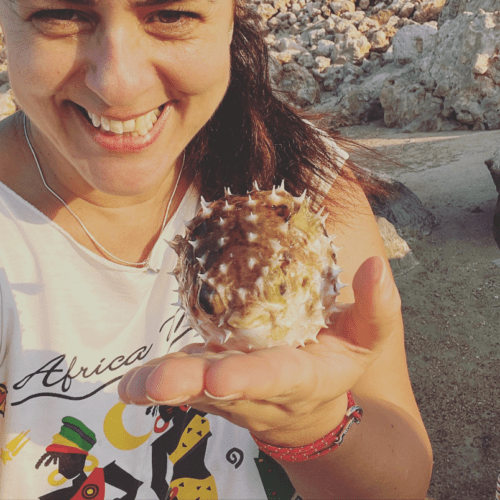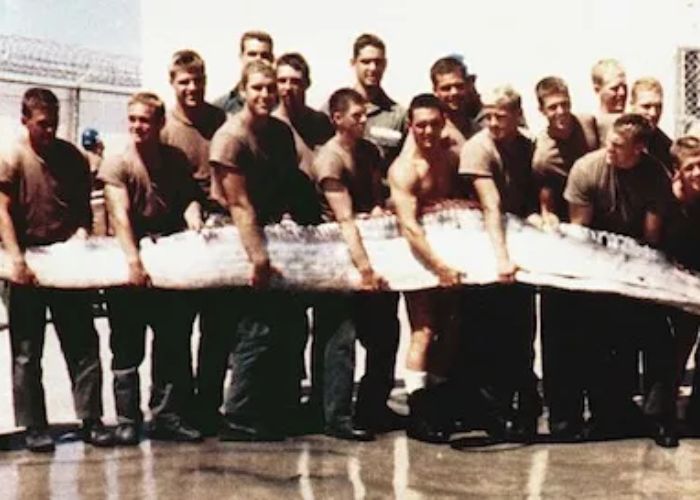As a marine biologist who has worked in the field for more than seven years, I find it very interesting when fisherman or researchers find new or rare kinds of fish. So when I heard about the strange fish caught off the coast of New Zealand’s North Island, it caught my attention right away. Its head looked like a seahorse, and its body was covered in bony ridges and spikes. Read below about “Fishermen Make Rare Catch – Doomsday Fish with a Seahorse Head?”.
The fish was caught by Steve Hathaway, a fisherman who runs fishing trips in the area. When he pulled up the strange-looking fish, which turned out to be a female frogfish, he was naturally confused. Frogfish, which are also called anglerfish, get their name from the way their heads look like seahorses and how they can “hop” along the bottom. I knew it right away because I know a lot about sea life.
Table of Contents
A Look at the Rare Catch
Hathaway got a frogfish that was about 30 cm long and 2 kg heavy. Its body was rough all over and had spiny protrusions all over it. It had a beautiful head with lots of folds and frills that helped it blend in with coral and sponges on the bottom.
As I looked at pictures of the catch, it became clear that the fish could hide. Its whole appearance lets it blend in with its surroundings, so both prey and enemies can’t see it. This is very important for the frogfish to stay alive.
The Life of the Mysterious Frogfish
We need to look at this fish’s way of life to figure out why it has such a strange appearance. When they’re not hunting, frogfish lie still on the seafloor or against coral and wait for their food to come close. When they see something tasty swimming nearby, they quickly open their big mouths and gulp it down. You can eat anything, even other frogfish, fish, shrimp, and crabs.
Frogfish spend more energy hiding themselves than moving because they don’t move around much. Their fins have changed over time so that they can move quickly instead of moving continuously. And the complicated folds and frills on their heads are a great way to hide. Because they look like coral, sponges, or anemones, they can eat animals that think they are safe structures.
While diving on study trips across the Pacific Ocean, I saw frogfish for myself. Seeing one suddenly come out of hiding and eat a passing fish in one swift move is a great reminder of how cruelly they can hunt. It’s over in a flash, and they don’t even pause to change back into their mask.
Rarity Makes This Catch Special

Hathaway’s catch was one of a kind because frogfish aren’t often seen in that part of New Zealand. I looked at distribution maps from previous study surveys and saw that frogfish have only been seen off of Northland a few times. Even though they have been seen before, they are not often.
As a marine scientist, finding a rare species in water where I don’t expect it gives me useful information for my work. If I had been the one to find this frogfish specimen, I would have written down important information like where it was found, how deep it was, how warm the water was, and any traits that made it stand out. For identification reasons, photos would also be very important. All of this can help us learn more about where sea life lives and how they act.
An Ominous Sign or Simply a Rare Catch?
Some news sites called the frogfish the “doomsday fish” when they heard about its discovery, as if it were a scary sign about the health of New Zealand’s oceans. As a marine scientist with a lot of knowledge, I like to avoid making hasty decisions.
In fact, strange fish catches happen all the time and aren’t always signs of an impending ecological disaster. Species show up every year in places no one has seen them before. In some cases, small changes in the surroundings have made their home range bigger. In others, people who are moving just wander into new areas.
There are real threats, like climate change and habitat loss, but one surprise finding doesn’t always mean disaster. It’s just an interesting piece of information that should be looked at more closely over time.
As a researcher, I once caught a rare type of shrimp in a place where no one knew it lived. Coworkers made wild guesses about how food chains might fall apart. But it hasn’t been seen again in years. That first shrimp was probably just stopping by from a nearby area. There was no mass catastrophe.
So, until more information comes in to show otherwise, I think this New Zealand frogfish is a one-of-a-kind find. It doesn’t help anyone to jump to negative assumptions without any proof. As experts, we need to use calm analysis to help us make decisions.
An Exciting Development for My Own Research
In my own life, hearing about the frogfish has made me rethink my survey plans for a study trip I’m taking to New Zealand soon. My group is going to look at coral reef communities near Northland. Also, since we now know that frogfish live in the area, we will use special tracking gear to look for more specimens.
As a PhD student many years ago, I used observations made in Papua New Guinea for my important work on how frogfish hide. I’m really excited about the idea of learning them in New Zealand too. We learn more about how these strange fish live and change with each new place we find them.
Conclusion
As fishermen, we never know when a simple catch could lead to new scientific discoveries. But random events like these are part of what makes marine biology so interesting, as scientists try to keep up with nature’s huge variety. I hope you like reading “Fishermen Make Rare Catch – Doomsday Fish with a Seahorse Head?”. I can’t wait to see what other amazing living things the oceans have in store for us!

Marta, the driving force behind WaterWorldCraze.com, holds a Master’s degree in Marine Biology and has extensive experience in water sports and activities. With over 7+ years of hands-on experience in marine research and conservation, she has participated in numerous underwater expeditions and projects. Her passion for the aquatic world shines through in her expertly curated content. Join Marta as she explores the wonders of marine life and shares her adventures. Connect with her on Instagram @marinebiologymarta for more insights and updates.

